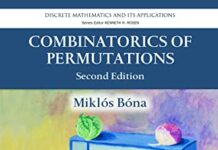
Ebook Info
- Published: 2011
- Number of pages: 568 pages
- Format: PDF
- File Size: 2.20 MB
- Authors: Miklos Bona
Description
This is a textbook for an introductory combinatorics course lasting one or two semesters. An extensive list of problems, ranging from routine exercises to research questions, is included. In each section, there are also exercises that contain material not explicitly discussed in the preceding text, so as to provide instructors with extra choices if they want to shift the emphasis of their course. Just as with the first two editions, the new edition walks the reader through the classic parts of combinatorial enumeration and graph theory, while also discussing some recent progress in the area: on the one hand, providing material that will help students learn the basic techniques, and on the other hand, showing that some questions at the forefront of research are comprehensible and accessible to the talented and hardworking undergraduate. The basic topics discussed are: the twelvefold way, cycles in permutations, the formula of inclusion and exclusion, the notion of graphs and trees, matchings, Eulerian and Hamiltonian cycles, and planar graphs. The selected advanced topics are: Ramsey theory, pattern avoidance, the probabilistic method, partially ordered sets, the theory of designs (new to this edition), enumeration under group action (new to this edition), generating functions of labeled and unlabeled structures and algorithms and complexity. As the goal of the book is to encourage students to learn more combinatorics, every effort has been made to provide them with a not only useful, but also enjoyable and engaging reading.
User’s Reviews
Editorial Reviews: From the Back Cover This is a textbook for an introductory combinatorics course lasting one or two semesters. An extensive list of problems, ranging from routine exercises to research questions, is included. In each section, there are also exercises that contain material not explicitly discussed in the preceding text, so as to provide instructors with extra choices if they want to shift the emphasis of their course. Just as with the first two editions, the new edition walks the reader through the classic parts of combinatorial enumeration and graph theory, while also discussing some recent progress in the area: on the one hand, providing material that will help students learn the basic techniques, and on the other hand, showing that some questions at the forefront of research are comprehensible and accessible to the talented and hardworking undergraduate. The basic topics discussed are: the twelvefold way, cycles in permutations, the formula of inclusion and exclusion, the notion of graphs and trees, matchings, Eulerian and Hamiltonian cycles, and planar graphs. The selected advanced topics are: Ramsey theory, pattern avoidance, the probabilistic method, partially ordered sets, the theory of designs (new to this edition), enumeration under group action (new to this edition), generating functions of labeled and unlabeled structures and algorithms and complexity. As the goal of the book is to encourage students to learn more combinatorics, every effort has been made to provide them with a not only useful, but also enjoyable and engaging reading.
Reviews from Amazon users which were colected at the time this book was published on the website:
⭐The moment the teacher gives out the assignment from this book, I find myself brimming with joy as I cannot wait until I get home. Every night as I flip through the soft tender pages full of knowledge, around 8:00pm the blood start flowing to my meat. As I steadily work through the problems my member becomes engorged with blood due to the beauty of the problems which in turn draws the blood away from my brain and makes it harder for me to work. This is a vicious cycle because the longer I look at the book, the bigger my erection becomes.I would recommend this book to anybody and everybody.
⭐I am a math major who is using this book for my combinatorics class. This book covers a lot of topics and I enjoy the author’s use of math in the real world for his examples and exercises. However, the only thing I dislike about the book are his proofs. I don’t enjoy reading his proofs because most of them seem too informal. He mixes in real life examples for his proofs of theorems. For example, Theorem 4.6 in the book. Overall, I don’t like the dialogue he uses in his proofs. It doesn’t feel like he’s instructing me. It feels too casual, too informal, as if we’re having a cup of coffee over the theorems and I continue to agree with everything he says and nod to him every minute. I understand as a math major I need to fill in the gaps he leaves behind because a proof DOES NOT have to provide reasoning. A proof only has to provide justification for each step.
⭐A great book for self-study. It is a bit more time consuming though and around senior junior undergraduate level. Nice examples given throughout the text. Combinatorics is an important field in theoretical CS and discrete math.
⭐Great textbook
⭐He does a short explanation in each chapter and few examples after that. Then at end of the chapter the author bomb you with problems, that if you don’t have anyone to ask then will be nearly impossible to solve. So guess what, you pay $60 just to google the material anyway.
⭐it is very good.fast and excellent
⭐I bought this paper book(3rd) because MIT OCW recommends it, but after read several chapters, I find it is not as good as amazon comments. at least for the beginner. I really recommend Richar Brunaldi’s Introductory Combinatorics.
⭐Just for disclosure, I’m a senior undergraduate in mathematics. This will suggest something about my background, which is always an important factor in how a work is received.It seems to be a general trend that participants in Olympiads write texts with a lot of problems — as opposed to none or just exercises. This is the kind of text Bona has written. There are hundreds of problems and they range in technique and difficulty. Personally, I think these are the best kinds of textbooks because they ask you to spend a lot of time on a few problems and this really helps you get in there and see what’s happening at a deeper level.But one thing unique about Bona’s text that is especially nice is the inclusion of detailed solutions to all of the problems not given in the supplementary sections. Writing a clear and instructive textbook is a great skill. But writing solutions to difficult problems is probably a more difficult skill to develop, yet Bona has it. All of the material here is very helpful for developing a strong base for future work in combinatorics.Another additional topic that I’m very happy he included is the section on complexity. Historically, combinatorics and complexity have been closely related, which is something that has only increased in recent decades. But Bona’s text is the only one I’ve seen that is introductory and includes a discussion of computational complexity. This is a wonderful feature to an already outstanding textbook.I’ve given the text four stars because I’ve read just three or four chapters. They’ve all been great, but this is less than half of the textbook.
Keywords
Free Download Walk Through Combinatorics, A: An Introduction To Enumeration And Graph Theory (3Rd Edition) 3rd Edition in PDF format
Walk Through Combinatorics, A: An Introduction To Enumeration And Graph Theory (3Rd Edition) 3rd Edition PDF Free Download
Download Walk Through Combinatorics, A: An Introduction To Enumeration And Graph Theory (3Rd Edition) 3rd Edition 2011 PDF Free
Walk Through Combinatorics, A: An Introduction To Enumeration And Graph Theory (3Rd Edition) 3rd Edition 2011 PDF Free Download
Download Walk Through Combinatorics, A: An Introduction To Enumeration And Graph Theory (3Rd Edition) 3rd Edition PDF
Free Download Ebook Walk Through Combinatorics, A: An Introduction To Enumeration And Graph Theory (3Rd Edition) 3rd Edition




